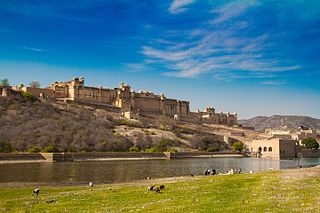Amer Fort
Amer, Jaipur, Rajasthan 302001
Phone : 0141 253 0293
11 Km From Jaipur on Delhi-Jaipur Highway

Amer Fort is a World Heritage Site.
Amer Fort (spelled and pronounced as Amber Fort and Amber Palace) is located in Amer, a town with an area of 4 square kilometres (1.5 sq mi) located 11 kilometres (6.8 mi) from Jaipur. Located high on a hill, it is the principal tourist attractions in the Jaipur area. The town of Amer Was originally built by Meenas, and later it was ruled by Raja Man Singh I (December 21, 1550 – July 6, 1614).
Amer Fort is known for its artistic Hindu style elements. With its large ramparts and series of gates and cobbled paths, the fort overlooks Maota Lake.It is the main source of water for the Amer Palace.
The aesthetic ambiance of the palace is seen within its walls. Constructed of red sandstone and marble, the attractive, opulent palace is laid out on four levels, each with a courtyard. It consists of the Diwan-e-Aam, or “Hall of Public Audience”, the Diwan-e-Khas, or “Hall of Private Audience”, the Sheesh Mahal (mirror palace), or Jai Mandir, and the Sukh Niwas where a cool climate is artificially created by winds that blow over a water cascade within the palace. Hence, the Amer Fort is also popularly known as the Amer Palace. The palace was the residence of the Rajput Maharajas and their families. At the entrance to the palace near the fort’s Ganesh Gate, there is a temple dedicated to Sila Devi, a goddess of the Chaitanya cult, which was given to Raja Man Singh when he defeated the Raja of Jessore, Bengal in 1604. (Jessore is now in Bangladesh).
This palace, along with Jaigarh Fort, is located immediately above on the Cheel ka Teela (Hill of Eagles) of the same Aravalli range of hills. The palace and Jaigarh Fort are considered one complex, as the two are connected by a subterranean passage. This passage was meant as an escape route in times of war to enable the royal family members and others in the Amer Fort to shift to the more redoubtable Jaigarh Fort.
At the 37th session of the World Heritage Committee held in Phnom Penh, Cambodia, in 2013, Amer Fort, along with five other forts of Rajasthan, was declared a UNESCO World Heritage Site as part of the group Hill Forts of Rajasthan.
Source : Wikipedia
Today, tourists can ride up to the fort from the base of the hill on elephants. On the ride, one can see the skyline of Jaipur, Maotha lake, and the original city walls. The fort can be toured with a guide or on one’s own. You also have audio guides available in various languages. The sound and light show in the evening is worth a view. The show is for 50 minutes and the timings are 6.30 pm in Hindi and 7.30pm in English.
One of the most striking parts of the fort is the Hall of Mirrors. Tour guides tell visitors that when the palace was occupied by royalty, the hall could be lit at night by a single candle because of all the tiny, intricate mirrors.
There is a tunnel connecting Amer fort and Jaigarh fort about 800 meters long , 14-foot deep pit, approximately 10 feet wide out of which about 325meters have been excavated and now open to public. This passage was meant as an escape route in times of war to enable the royal family members and others in the Amer Fort to shift to the more redoubtable Jaigarh Fort.

https://www.youtube.com/watch?v=4DX4hMCP120
https://www.youtube.com/watch?v=ry-EKj7TxNs
Elephant ride at Amer fort
The tunnel connecting Amer and Jaigarh Fort
https://www.youtube.com/watch?v=9wzVI-PhCeA
Light & sound show at Amer fort
https://www.youtube.com/watch?v=ch1sctpJtk0
Reviews
Entry fee : Rs. 25/- for Indians, Rs. 50/- for foreign tourists, Rs. 50/- for still camera for Indians, Rs..100/- for video camera for Indians, Rs.70/- for still camera for foreign tourists, Rs.150/- for video camera for foreign tourists


Rate this article